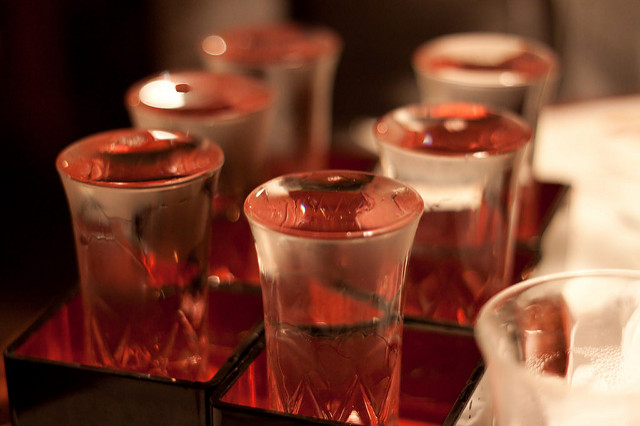
photo by Kim Nilsson
Traditional Japanese cuisine “washoku” has been in the spotlight more than ever since it was designated an intangible cultural heritage by UNESCO. Japanese sake, which is often described as a rice wine in English, is one of the most important ingredients for Japanese cuisine. If you are in Japan, don’t miss this chance to enjoy genuine sake here. A glass, a little sake cup or many other vessels are used to serve sake. But what about having it in a traditional “masu”? It probably is little known internationally. Let’s find out what “masu” is, and appropriate manners to drink sake from a “masu”.
What is “Masu”?
Originally, a “masu” was used to measure rice or other types of grain when the lord takes food tax during the feudal period. The beautiful wood grain pattern, aroma of wood and the beauty of its form drew more attentions at a later time, and people started using it as a drinking cup at celebrations. “Masu” is traditionally considered to remove the negative vibes and widely used in a variety of ceremonies. It is common to order “masu” at wedding with names of bride and groom or crests of both families branded on it. “Masu” is also commonly used as a gift at parties. Japanese cedar was originally used for “masu” making, but Japanese cypress is more used in recent years for its beautiful color and aroma. Japanese cypress is very familiar material in Japanese lifestyle: it is widely used for construction of shrines and temples, as well as for chopping boards and counter board in a sushi shop as it has a high antibacterial effect. “Masu” is getting more attentions from overseas as a Japanese traditional utensil.
“Masu Zake” Do’s and Don’ts
Before you start your “masu zake”, make sure you follow the proper manners to enjoy it.
Hold “Masu” in Right Hand, Four Fingers under Bottom, Thumb on Rim
Hold “masu” with four fingers of your right hand and put thumb on the rim. Do not grab it. Putting your bottom lip along a straight side of the rim and sip with a slurping noise is the correct way to drink it.
Sip from Straight Side of Rim
You might think drinking from a pointy corner of the rim would be easier. But this is wrong way. Sip from a straight side of the rim. By the way, Japanese samurais in old time would hold a “masu” in the left hand as they had to keep their right hand free all the time, in case they needed to draw a sword for a battle. But we hold it in the right hand in modern days.
More Sophisticated Manners
Following is a traditional and more sophisticated way to enjoy “Masu Zake”. This is little known even by Japanese nations.
Keep Wood Grain on the Bottom Running Sideways
Hold a “masu” to keep the Wood grain on the bottom running sideways. Traditionally, having the wood grain of “zen (a tray with legs attached)” running vertically is considered foreboding. The wood grain pattern of a tray must be kept sideways from a guest’s side when it is placed on the surface. This is just a minor thing, but well expressing a welcoming spirit of Japanese people.
Salt on Right Corner of “Masu” from Your Side
Put some salt on the right corner of “masu” from your side when you drink sake. In old time, people used to have a little mount of salt while they drink sake. Also, putting salt is meant to purify human body and soul. Salt and sake are often paired as offerings to a god. Salt on “masu” comes from this custom. Salt is put on the right opposite corner from your side, a little off from the end.
Move Salt to Where Your Lip is Placed, Or Drop Salt into “Masu Zake”
When you drink sake, move salt little by little to where your lip is placed, or drop a tiny amount of salt into “masu” before you sip. Accentuated sweetness of sake by adding salt and gentle aroma of wood make the sake tastes even richer. You will be a connoisseur of Japanese culture by knowing this.
Let’s Do Things the Old Way
In recent years in Japan, sake tends to be served in a glass or other handier vessels, and a “masu” has less opportunities to be used. However, drinking sake from a traditional “masu” still entertains us by its original beauty of the old and unique wooden features of the vessel, which a glass or other drinking cups lack. In addition, every episodes or rules regarding “masu zake” are deeply linked to many aspects of Japanese culture. This also tells you the complexity of washoku, Japanese sake and Japanese culture itself. Try “masu zake” when you visit Japan next time.
Related Article:
4 Japanese sake brewery tour recommendations for foreigners
“Mokkiri” etiquette for non-Japanese and Japanese
